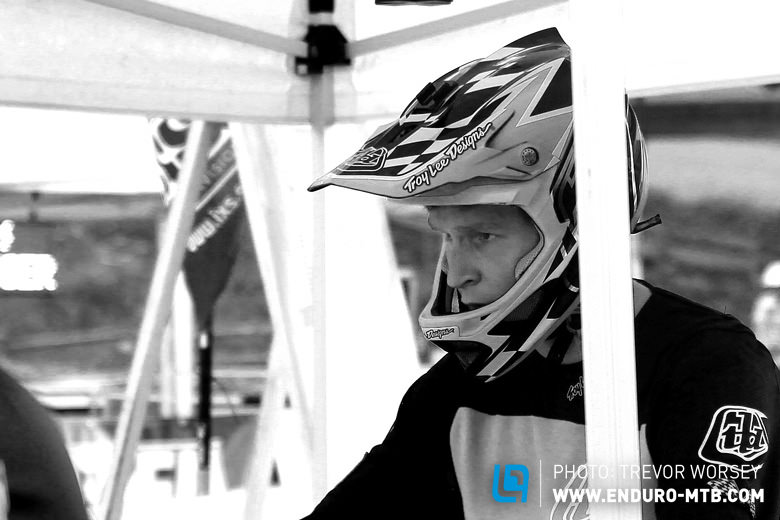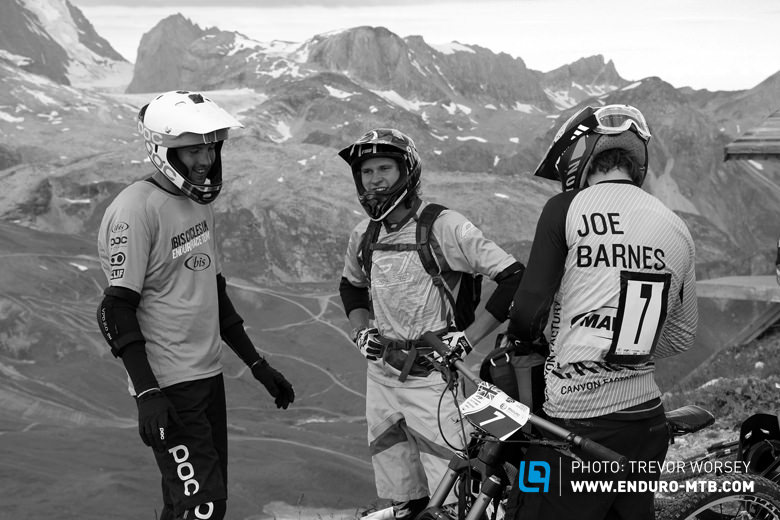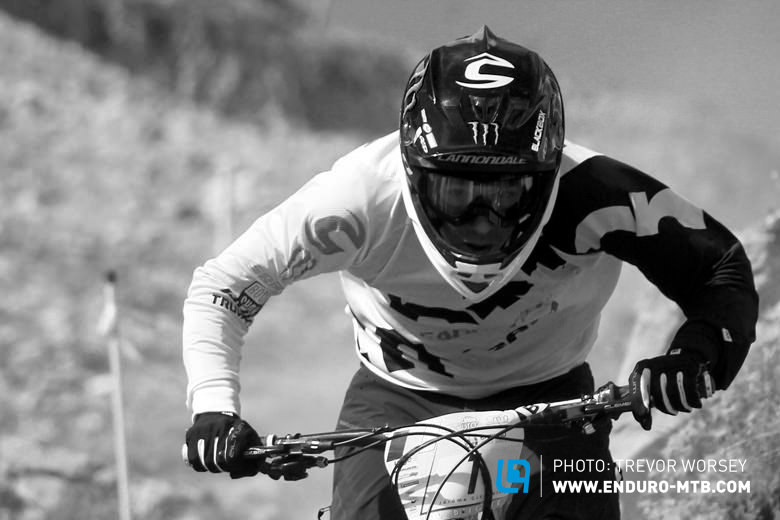Those last 10 seconds: Inside the minds of champions

There is no feeling like it, those last 10 seconds of quiet and calm before the explosion of physical power; you watch the queue move forward, one racer at a time. Getting closer, you start to feel the nerves creep in, where was that big rock drop? What was the best line through the roots? 4 riders still to go, you drop your goggles and sort out the strap. Still damp from the perspiration fog creeps in to the corners, too early, off they come! You check and recheck the gears, flex your feet through the pedals. You try and relax but adrenalin burns like caffeine, flooding your blood stream.
One rider left before you, you watch his clock count down, knuckles tight on the grips, then he is gone, looking fast out of the gate? Will you be fast enough? You roll to the start line, adrenalin surging, goggles on, you stare down the ribbon of trail into the first corner. 10, 9, you try and relax your grip, 8,7 your helmet strap feels too tight, perhaps you should have checked it, 6,5 breathing is fast, how hard should you push from the gate, 4,3 was it the left or right line through that tough rock garden? 2, 1! PEDAL PEDAL PEDAL!!

Have you ever set off out of the gate and blown the first corner while racing, set off too fast into a stage and forgotten the well chosen lines you had scoped? Think of all the mistakes you make in the racing environment, think of all those seconds that have slipped away. Finding those seconds physically is a tough process, it takes hours of training for small incremental improvements in muscular performance, but professional racers know the easiest way to save time is to make fewer mistakes. Without any Hocus Pocus or Mumbo Jumbo, racers at the top end of the sport are able to remain focused and calm while the situation is electric. This skill is innate for some but in others needs to be developed, working on a mental tool set to provide a competitive edge.

“Many years ago my Dad once told me to take 4 deep breaths before you go to oxygenate the blood. Anymore and it can be negative and you’ll get sweedged on oxygen and any less and you will miss out on the good times. I don’t know whether it’s true or not but it gets you in the zone, relaxed and keen for smashing it up. In the last 10 seconds I don’t like to think about anything, I like to do all this before, pedalling up the climb or on the lift and then just relax before the start. The last 10 second oxygen intake works well to help focus as it’s a good routine that is consistent wherever you are.” Joe Barnes
“I over-breath a lot before the start to be ready to give everything. Before that I try to remember the track and see my lines in my head. But 10 sec before the start the race has already started so it’s too late to thing about anything except to get focused on the countdown, listen to the starter, watch the clock and be ready to push as hard as you can on the pedals to exit the gate as quick as possible (without starting too early, which mean you get a penalty).” Jerome Clementz, EWS World Champion

When we look at what happens to a rider at the start gate, from a biological standpoint one of the first things that occur when a person feels pressure is acceleration of the heart rate. Effective thought becomes increasingly difficult as the heart rate rises, once the rate gets to 120bpm mental acuity diminishes and at 150bpm the brain effectively shuts down into survival mode. Looking at Joe and Jerome’s preparation, it is clear that breathing is an important part of their grounding. Many studies have shown that an effective way to control heart rate is to use centered breathing before competition, pulling air into the diaphragm. This helps to lower the heart rate significantly.
Yoga gurus spend years practicing centred breathing, but to simplify matters all we need really do is take a good long breath. It has been shown that a fifteen second breath will effectively pull air into the diaphragm and help control heart rate. A lot of professional sports people swear by the 6-2-7 technique, If you can perform a 6 seconds in, hold for 2, out for 7 then you will be breathing from the diaphragm. Taking a deep centering breath will allow you to keep your pre-start heart rate under control, focus your mind and improve your brain function. Make it part of your pre-race ritual and you may become more focused than ever before.

“I would have just finished listening to that one song, that one song that no matter what’s up or where I am, gets me pumped to go. As it finishes the iPhone goes away and it’s time to line up. It’s high fives all around and ‘good lucks’ but after that it’s silence. The countdown begins 30 seconds to go. 15, 10! “Nail that start and you got this. C’mon Lochy, let’s do it. Go time”!!! Up on the pedals, mind goes blank” Scott Laughland
“The last 10 seconds are all about relaxing for me, my mind is kind of blank, just focusing on being as efficient as possible. The only thing I think of is to not go out too hard, especially when you are fresh at the start of a stage. However coming from an explosive 4X/BMX and DH background going out too hard in stages is something I struggle with!” Jared Graves
The average person has up to 60,000 thoughts a day; if we do not choose our thoughts carefully they can have a negative impact on performance, what do you think of on a race stage? Extensive research in sports psychology confirms that an athlete’s internal dialogue significantly influences performance. Looking at Scott’s build up, you can see that as a top Enduro racer it is important to come up with a ‘performance statement’, one thought to help focus your mind. Avoid ‘don’t‘ thinking, for example ‘don’t mess up’ keep it positive, simple and specific, for example you could use ‘Relax, stay loose.
Come up with your own performance statement and use it as much as you can during training, having this statement at hand will be very useful on race day, whenever you feel nervous or are having negative thoughts about a mistake in the stage, replace it with your performance statement, focus your mind, and find new levels of performance.
Everyone has different rituals before setting off into a stage, but there is always time to be saved by being in control of yourself, it is easier to save seconds than have to earn them back.
Words and photos: Trev Worsey
Did you enjoy this article? If so, we would be stoked if you decide to support us with a monthly contribution. By becoming a supporter of ENDURO, you will help secure a sustainable future for high-quality mountain bike journalism. Click here to learn more.







